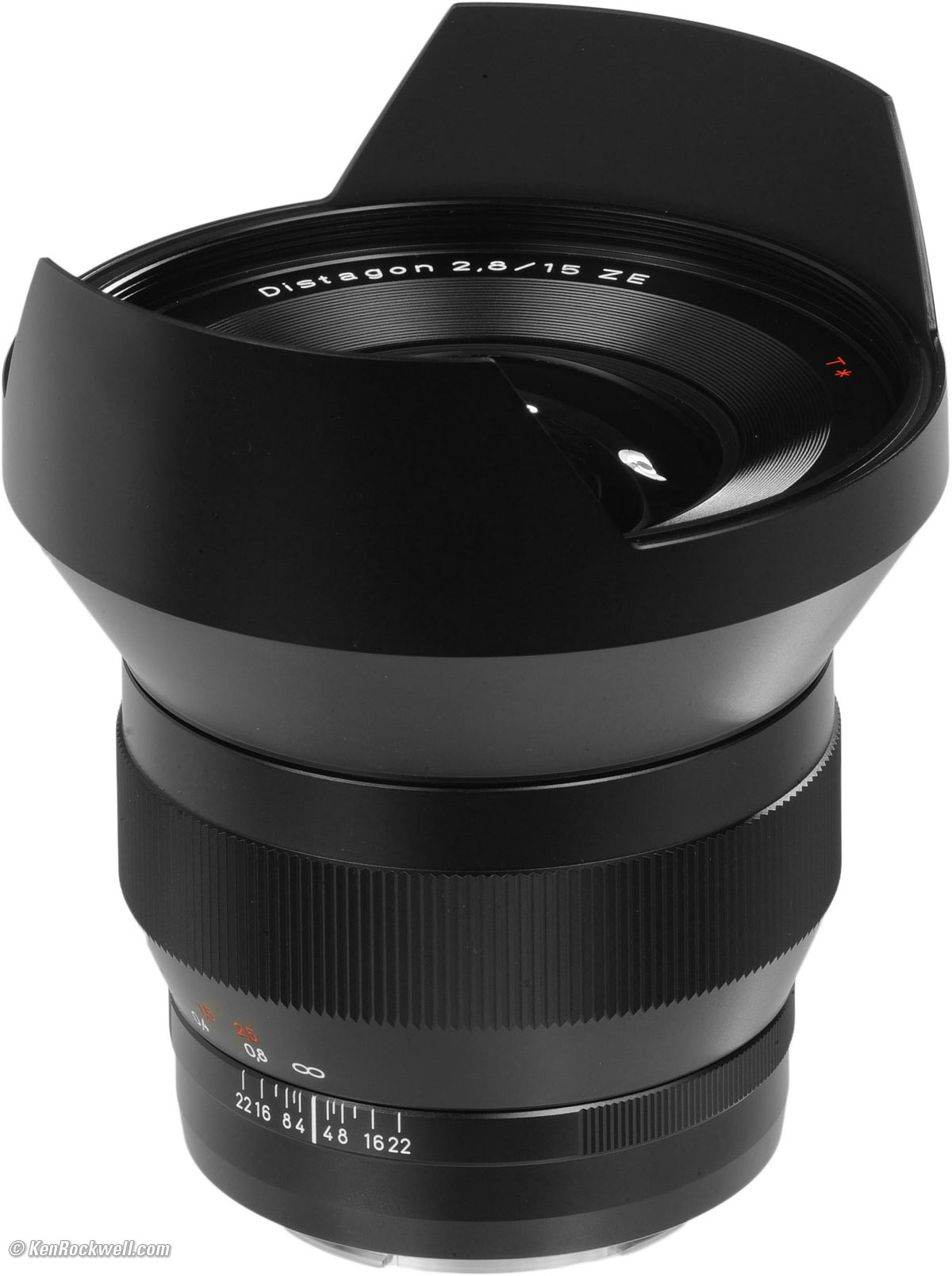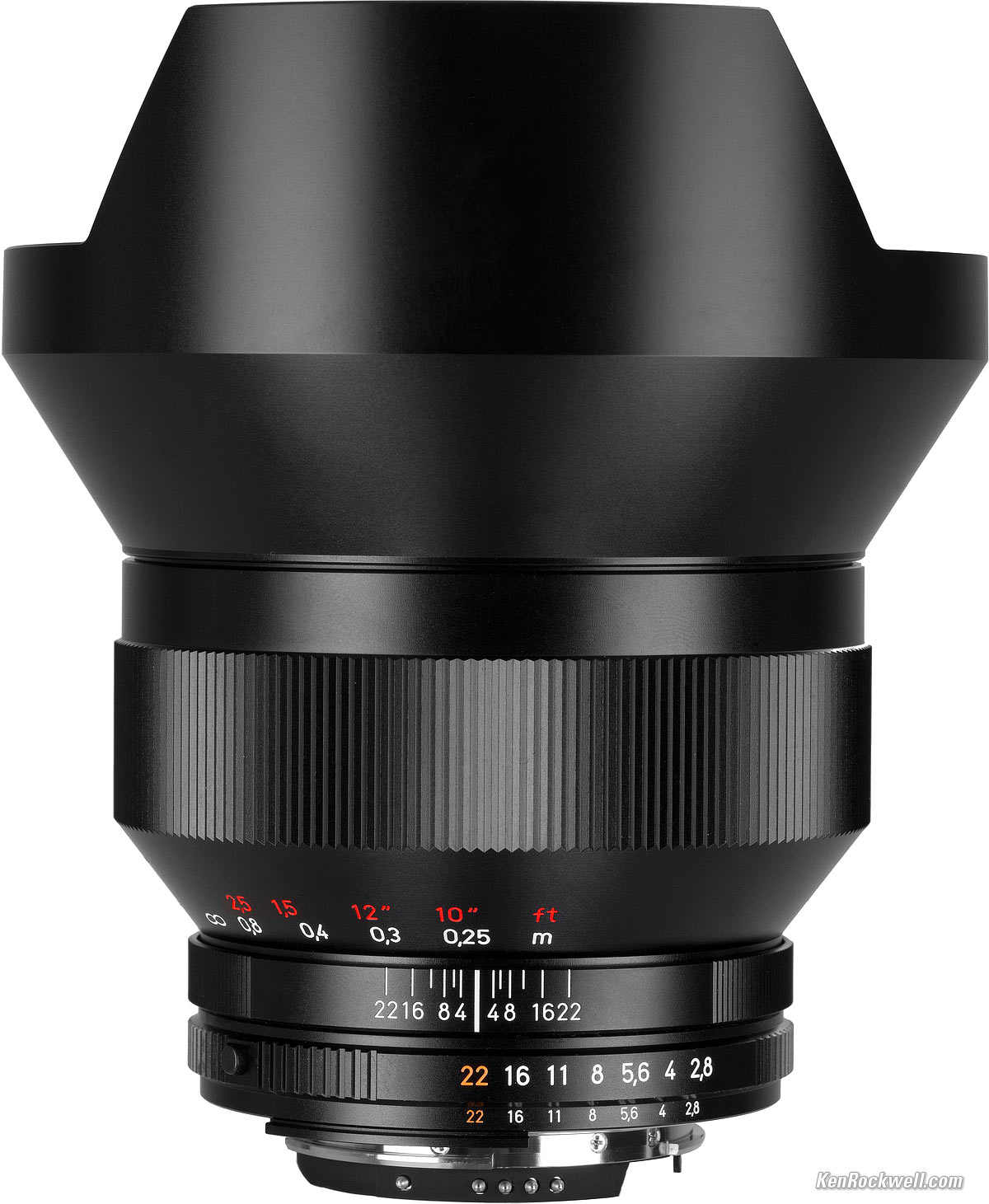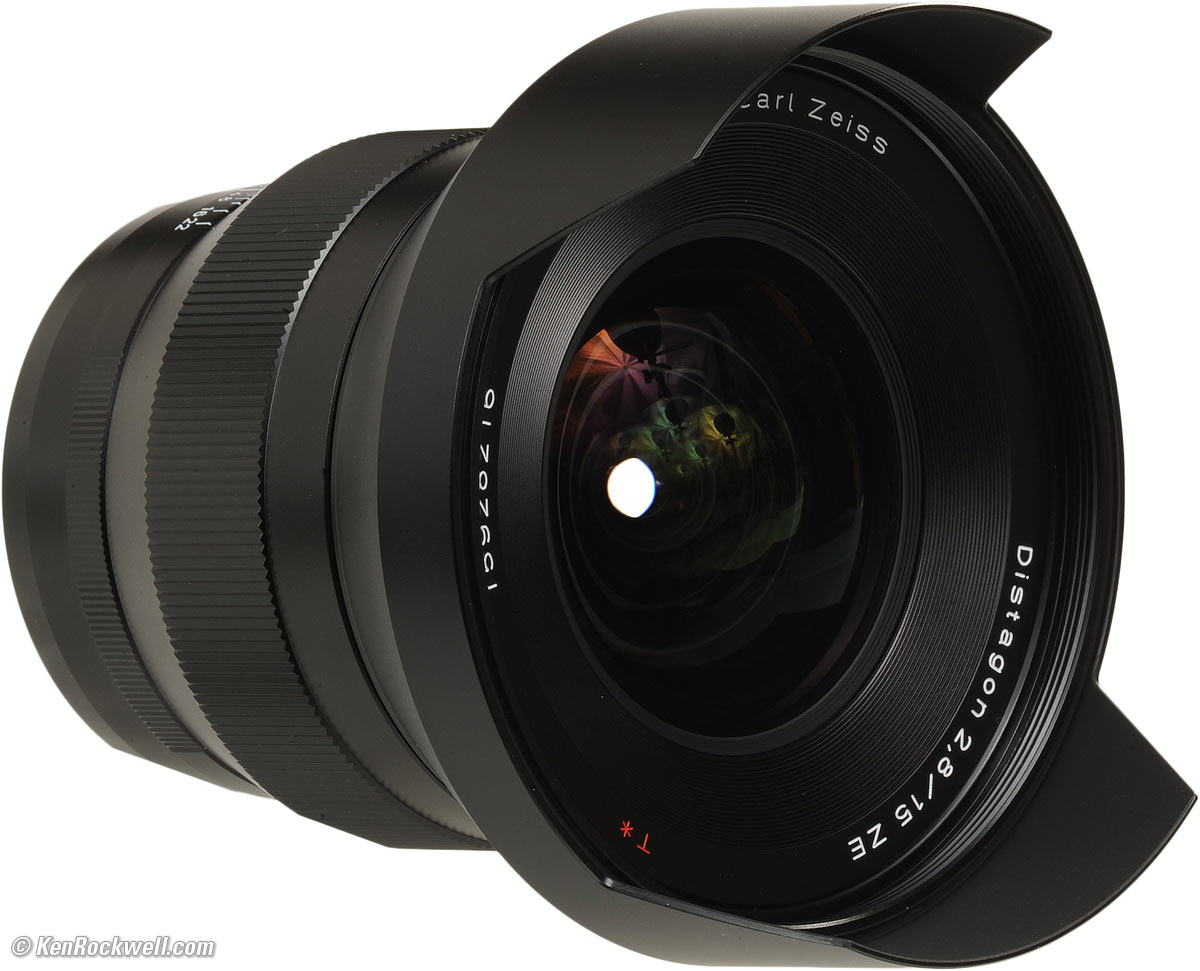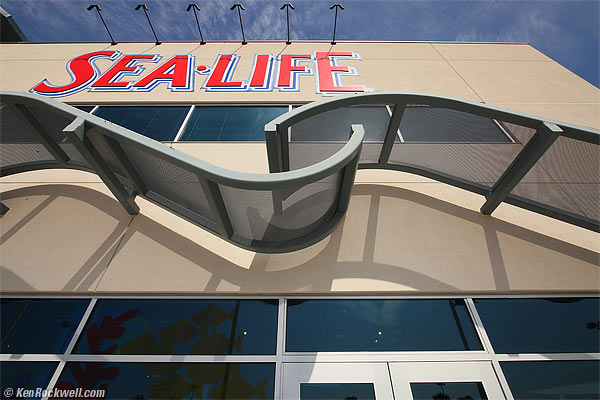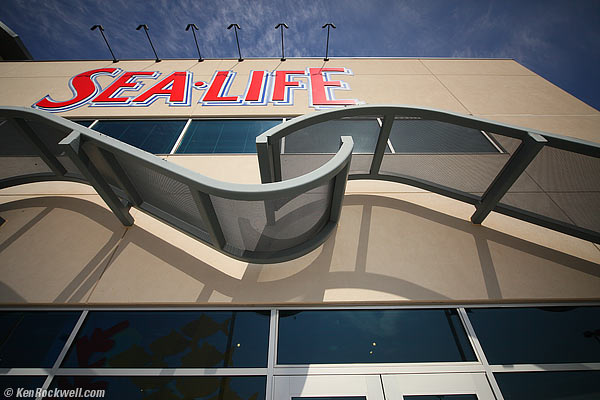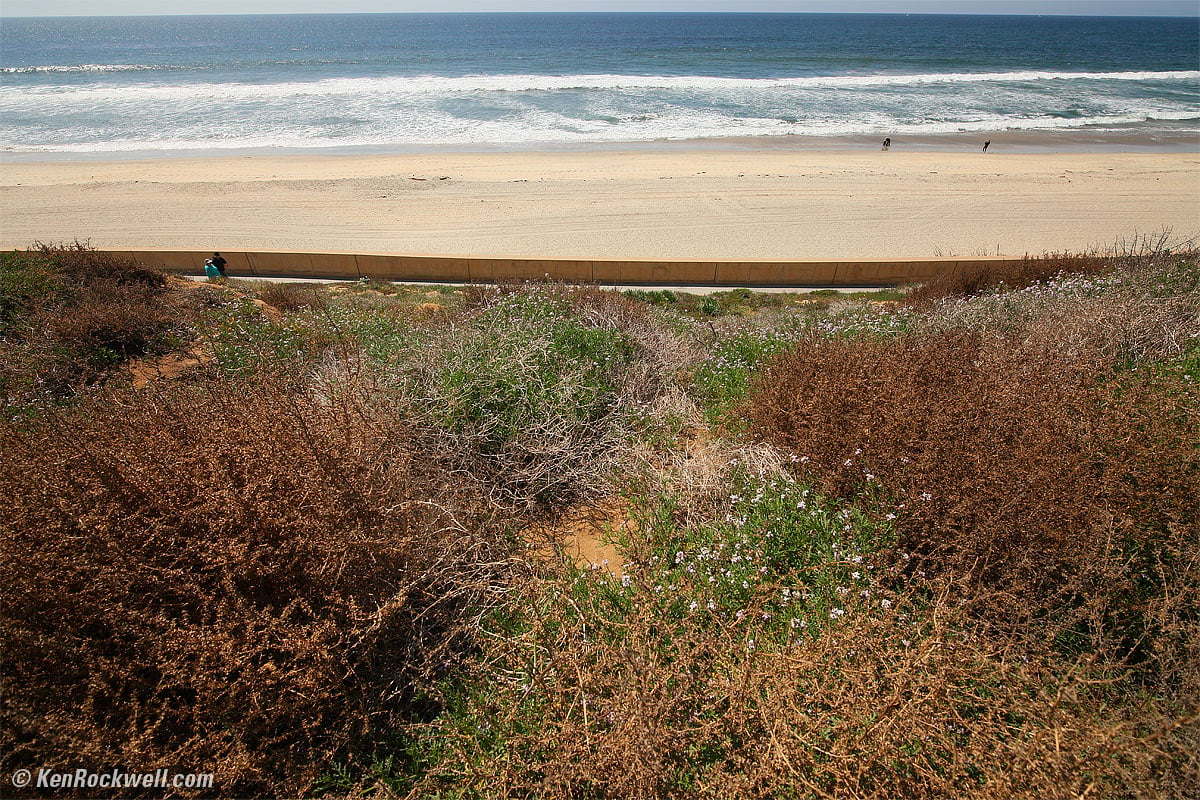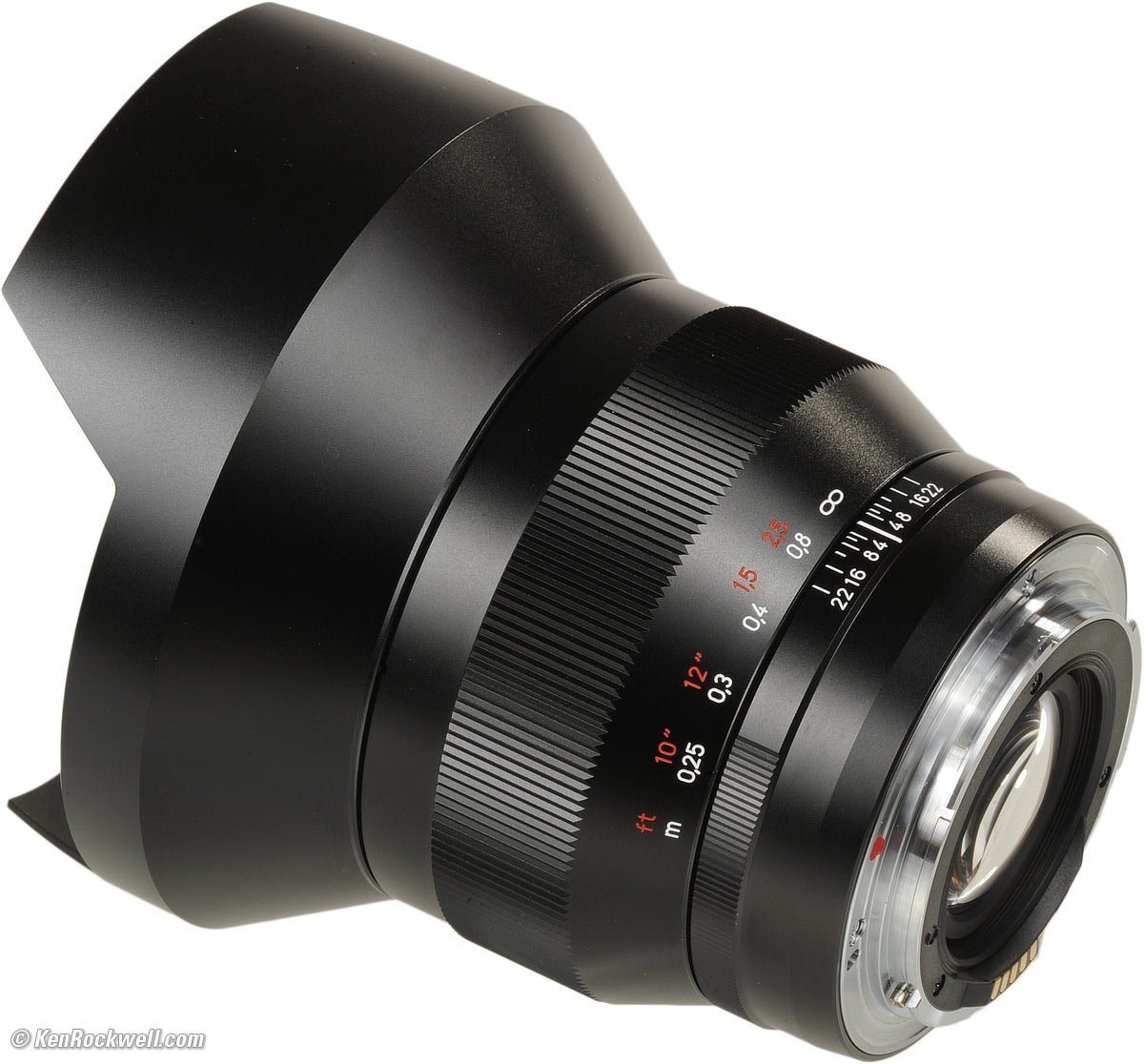Home Donate New Search Gallery Reviews How-To Books Links Workshops About Contact
Zeiss 15mm f/2.8 ASPH
Distagon T✻ ZF.2 (Nikon) & ZE (Canon)
Intro Specs Performance Compared Recommendations
Zeiss Distagon T✻ 15mm f/2.8, ZE Canon version (95mm filters, 26.4 oz./748g, 10"/0.25m close-focus, $1,999). enlarge.
Zeiss Distagon T✻ 15mm f/2.8, Nikon ZF.2 version. enlarge. (95mm filters, 25.8 oz./730g), 10"/0.25m close-focus, $1,999).This free website's biggest source of support is when you use those or any of these links when you get anything, regardless of the country in which you live. Thanks! Ken.
March 2012 Zeiss Reviews Nikon Canon All Reviews
Zeiss Manual-Focus Lenses for Canon
Introduction top
Intro Specs Performance Compared Recommendations
|
|
This Zeiss 15mm f/2.8 Distagon is a full-frame, manual-focus-only, fully meter- and EXIF-coupled lens for Nikon or Canon SLRs.
Compared head-to-head at the test range, this Zeiss 15/2.8 is much sharper than any of Canon's newest ultrawide lenses or zooms like the 16-35mm f/2.8 L II or 17-40mm f/4 L, or the Canon EF 14mm f/2.8 USM or Canon 14mm f/2.8 L II.
This Zeiss lens is bigger, heavier and costs more — and is optically far superior.
If you're a Canon full-frame shooter who wants more sharpness than you're getting from Canon's ultrawide lenses (and no color fringes), this is a significant step up — if you don't mind manual focus.
I had no Nikon version to pit against Nikon; I suspect it's about as sharp as Nikon's 16-35mm VR, but better made, has much less distortion and is twice as sensitive to light, but lacking AF and VR. This Zeiss should be far sharper than Nikon's 15mm f/3.5 and 15mm f/5.6 manual-focus lenses, but with a little more distortion (those old Nikon 15mm lenses have no distortion).
This Zeiss lens is much better made mechanically either Nikon's or Canon's AF SLR lenses today.
This Zeiss lens is manual-focus only. It will not autofocus on any camera, while everything else like exposure automation and EXIF all work perfectly.
This is the world's only 15mm or shorter full-frame SLR lens that takes screw-in front filters, so we finally can use our grads on our ultrawide lenses where we need them.
Compatibility top
Für Canon: ZE
On Canon, focus confirmation lights work, as does auto exposure and EXIF data.
Zeiss 15/2.8, Canon version. enlarge.
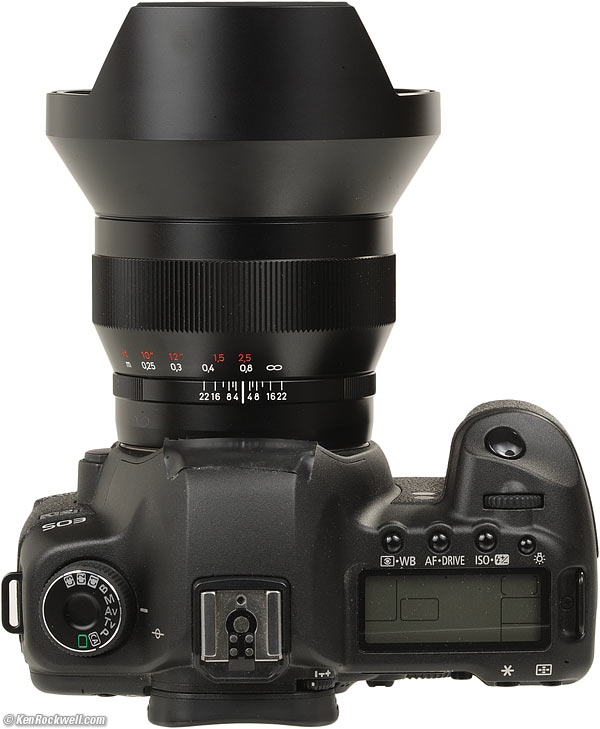
Zeiss 15mm f/2.8 on Canon 5D Mark II.
Für Nikon: ZF.2
This CPU and AI-s lens works perfectly with every Nikon SLR made from 1977 through today's latest DSLRs, from the D4X, D800 and D800E down to Nikon's cheapest D3100, so long as you don't mind focusing manually.
It has no coupling prong to meter with Nikon F-mount cameras made before 1977; you'll need to add a prong to meter with the Nikon F and early F2s, but even if you don't, it shoots perfectly.
Specifications top
Intro Specs Performance Compared Recommendations
Name
Zeiss calls this the Carl Zeiss Distagon T* 2,8/15.
T* "is Zeiss' trademark for its multicoating.
The Nikon AI-s mount with CPU is suffixed "ZF.2."
The Canon EOS EF mount shown in this review is suffixed "ZE."
Optics top
Zeiss 15mm f/2.8 internal diagram, Nikon mount. bigger.
15 elements in 12 groups.
Rear-element focusing for great correction at every focus distance. Nothing moves on the outside except for the focus ring.
Two aspheric lenses.
Abnormal partial dispersion glass.
Black-edge-painted glass.
Diaphragm top
Canon version front, Zeiss 15/2.8 at f/2.8. enlarge.
9 blades.
Stops down to f/22.
Focal Length top
Focal length: 15mm.
When used on a Nikon DX camera, sees about the same angle-of-view on DX as a 23mm lens sees on a 35mm camera.
When used on a Canon 1.6x camera, sees about the same angle-of-view on DX as a 24mm lens sees on a 35mm camera.
When used on a Canon 1.3x camera, sees about the same angle-of-view on DX as a 19mm lens sees on a 35mm camera.
Angle-of-View (on 24x36mm frame) top
110º diagonal.
100° horizontal.
76° vertical.
Close Focus
10 inches (0.25 m) from the image plane.
3.54 inches (0.09 m) from the front of the lens.
Maximum Reproduction Ratio
1:9. example.
Minimum subject area (24x36mm image size)
340 x 221 mm. example.
13.39 x 8.70 inches. example.
Focus Ring Rotation
The 15/2.8 focuses from infinity down to 0.25m in a short, fast 57º rotation of the focus ring.
Filter Thread top
95mm, standard 1.0mm pitch.
Metal.
Does not move.
Hood top
None; the upper and lower extension of the mount are mostly for front-element protection from knocks.
Caps top
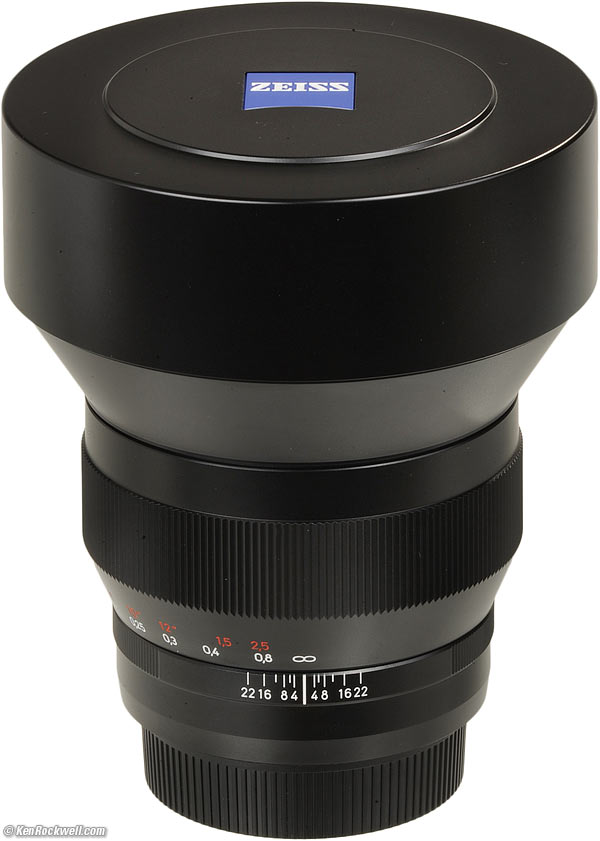
Zeiss 15/2.8 mit caps.
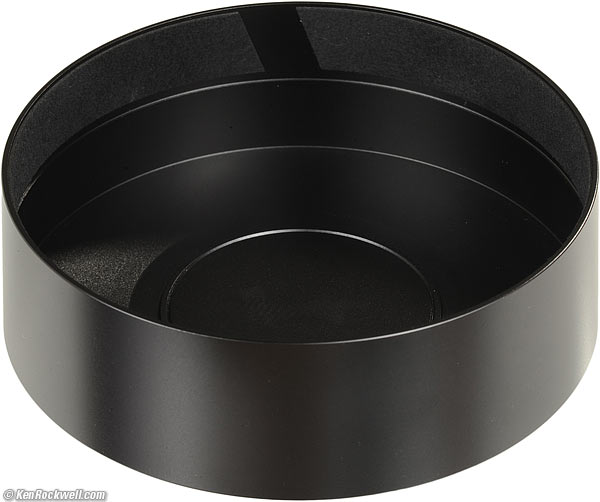
Zeiss solid billet aluminum front cap.
While Nikon and Canon left the professional world years ago and only supply wimpy plastic caps with their most expensive lenses, this Zeiss is the only current SLR lens to come with a real metal front cap.
Canon's first Canon EF 14mm f/2.8 USM came with a solid metal front cap, while today's Canon 14mm f/2.8 L II only comes with a crappy piece of plastic.
Nikon's first two 15mm f/3.5 and 15mm f/5.6 manual-focus lenses came with real metal caps, while today's 14mm f/2.8 and 14~24mm f/2.8 only come with either a sock or a crappy plastic thing that doesn't even block dust.
Thank God someone's making a professional ultrawide lens today.
Size (including caps) top
Nikon
4.06" (103mm) diameter x 5.20" (132mm) long, specified.
Canon
4.06" (103mm) diameter x 5.31 " (135mm) long, specified.
Weight top
Nikon
Zeiss specifies 25.75 oz. (730g).
Canon
26.387 oz. (748.05g), measured.
29.157 oz. (826.7g), measured, with Zeiss caps.
Zeiss specifies 28.9 oz. (820g).
Scope of Delivery
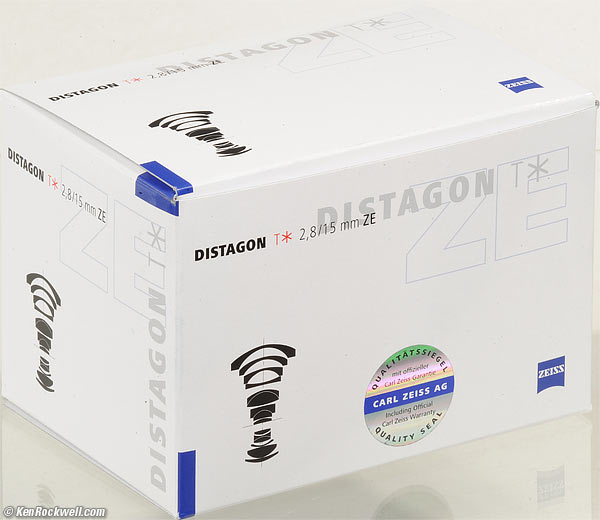
Box, Zeiss 15/2.8.
Includes lens, metal front cap, plastic rear cap and impressive paperwork.
Announced top
16 March 2012.
Promised top
Ought to ship in May 2012.
Zeiss Item Numbers top
2,8/15 ZE (Canon): 1964-830.
2,8/15 ZF.2 (Nikon): 1964-831.
Price, USA top
May 2017
$1,999: Nikon AI-s mount with CPU.
$1,999: Canon EOS EF mount.
March 2012
$2,950: Nikon AI-s mount with CPU.
$2,950: Canon EOS EF mount.
(€2,148 excluding VAT.)
Performance top
Intro Specs Performance Compared Recommendations
Overall Data Distortion Ergonomics Falloff Filters
Flare and Ghosts Focus Lateral Color Fringes Macro
Overall performance top
This Zeiss outperforms and is better-built than any of Canon's or Nikon's ultrawide zooms or 14mm lenses, but it's big, expensive and manual-focus only.
Nothing from Nikon or Canon can do this:
Sea•Life, f/10 at 1/500 at ISO 200, Canon 5D Mark II. original file.
None of Canon's zooms or 14mm are this sharp; look at the original file and the darn Zeiss lens is on the verge of exciting aliases on the grate perforations all the way out to the edges!
Nikon and Canon's zooms and Nikon's 14mm are loaded with distortion, so the horizontal lines would bulge-out from the center, not be straight as they are here.
Even if a Nikon or Canon lens might be sharp, like the Nikon 16-35mm, it's loaded with distortion. Once you correct the distortion in Photoshop or otherwise, you lose resolution from resampling.
If you chose a Nikon or Canon ultrawide devoid of distortion, like the Nikon fixed 15mm or Canon fixed 14mm, they aren't sharp; and all the Canon lenses are loaded with lateral color. This Zeiss is astounding in that it has no lateral color on the Canon 5D Mark II; the edges look as they're supposed to without color fringes.
Even if Nikon or Canon had a lens which was both sharp and undistorted at f/11 as above, they certainly have nothing that can do this at f/2.8:
Sea•Life, f/2.8 at 1/8,000 at ISO 200, Canon 5D Mark II. original file.
Yes, the Zeiss 15/2,8 is so sharp that it's exciting aliases in the center, and doing a very good job of trying even on the sides. Even when reduced onscreen here, you can see that all the perforations are exciting moiré on the right side as Photoshop CS5 tried to resize it to 600 pixels here. Bravo! original f/2.8 file.
Data performance top
This Canon-version makes files whose EXIF correctly reads the shooting aperture, and reads "15mm" for lens.
On Canon, from 1980s film EOS to today's digitals, everything seems to work perfectly.
Distortion performance top
There is very little distortion, thankfully. It's usually invisible, which is far better than any of Canon's or Nikon's ultrawide zooms or 14mm lenses.
The Sea, f/10. bigger.

Lockers at Musée d'Orsay.
What little distortion might be visible is a little bulging around the center, while lines along the edges are very straight.
In this sample, the doors are less straight than this lens!
Photoshop's Lens Distortion tool is too simple to remove this small amount of complex distortion.
Here's Zeiss' specification:
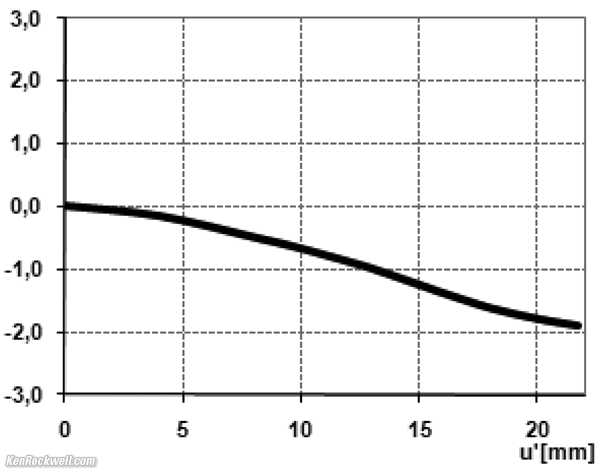
Zeiss 15mm f/2.8 distortion, % versus image height.
Ergonomics performance top
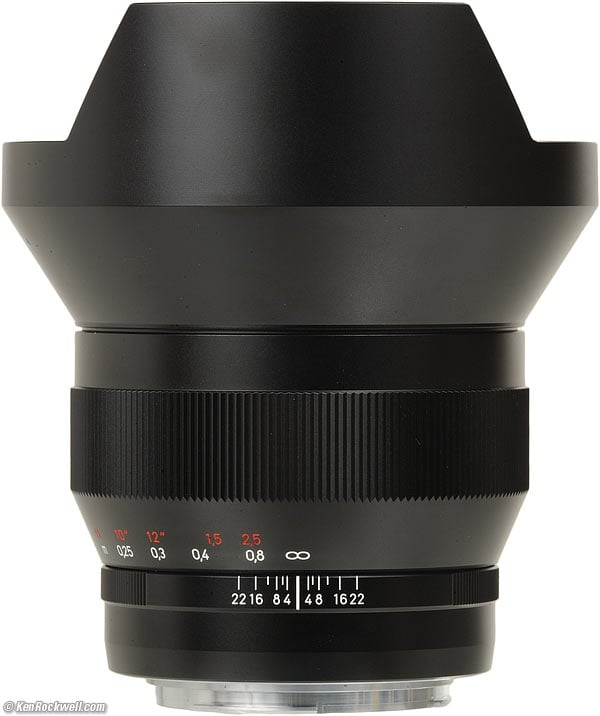
Canon version, Zeiss 15/2.8 ZE.
Unlike today's plastic zooms, this is all-metal. If you're used to plopping your Nikon and Canon plastic beauties down on your glass table or desktop, back off — you need to be careful with these heavy metal Zeiss lenses.
Thank goodness each version focuses in the same direction as do Nikon's and Canon's own lenses.
Focus is super-smooth, fast and optimally damped. Just a fingertip can slide it around.
The red footage engravings are invisible. They stand out these well-lit photos because I've bumped-up the color saturation which lightness the red. In anything but direct sunlight, they are actually dark burgundy on black.
The EOS mount has no external red index dot, as do Canon's own lenses. You have to look for the red dot on the back of the mount, which is a pain!
There is no "15" engraved on the side. You have to just know that this big thing is your 15mm.
Falloff (darkened corners) performance top
Falloff is strong at f/2.8, much less at f/4, and gone by f/5.6.
On Canon and Nikon, there is no profile available for automatic peripheral illumination correction.
I've greatly exaggerated the falloff of the Zeiss 15mm f/2.8 Distagon below by shooting a gray field and presenting it on another gray field:
Zeiss 15mm f/2.8 Distagon uncorrected falloff on 24x36mm at infinity.
© 2012 KenRockwell.com. All rights reserved. |
Here's Zeiss' rated performance:
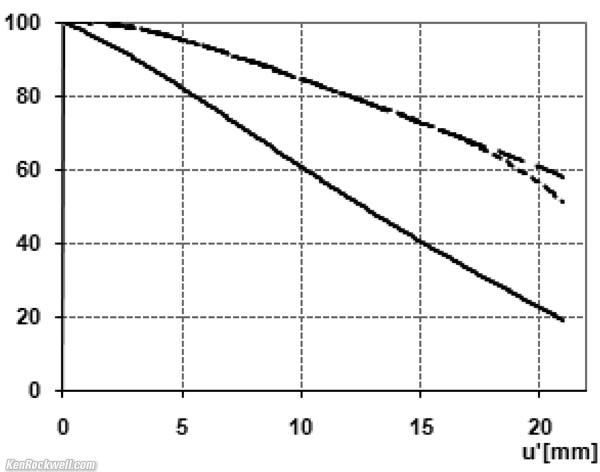
Zeiss 15mm f/2.8 Falloff of Illumination.
The top two lines are f/8 and f/5.6. The bottom line is f/2.8. f/4 is curiously absent.
Filters, Use with performance top

Zeiss 15mm f/2.8 with a relatively thin 95mm filter.
The filter ring never rotates, and 95mm filters easily screw on and off inside the fixed metal upper and lower guards.
There's a catch: my big professional 95mm filters from Hoya and Schneider are mounted in 9mm-thick rings, excluding their rear threads. With these standard filters, there is visible vignetting in the corners, making these filters far less useful unless you're cropping the sides.
In other words, this is one of the few lenses that demands special thin filters to work well. This is sad, considering that my Zeiss 35mm f/3.5 ultrawide for my Contax 645 works perfectly with the same 95mm filters. Whoops!
Don't bother with polarizers on ultrawide lenses. The polarization of the natural world varies so much over this lens' huge angle-of-view that polarizers lead to weird dark bands over your picture with ultrawide lenses. See an example of wide-angle polarization.
Flare and Ghosts performance top
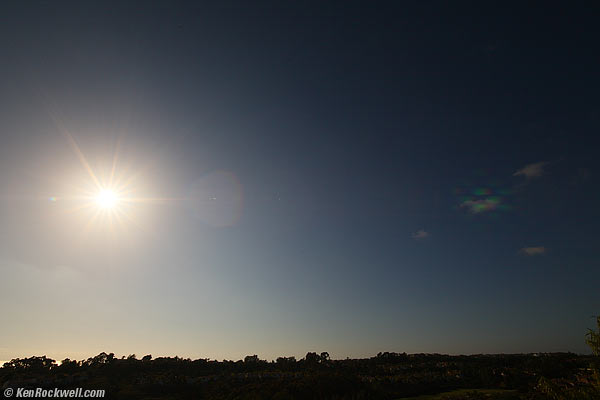
Zeiss 15mm f/2.8 chromatic ghost.
For a 15mm lens, flare and ghosts are very, very low. For comparison, the Nikon 15mm f/3.5 is awful, while this Zeiss has no flare or ghosts unless you do something deliberately stupid.
If you are silly enough to point it at the sun, there is one dim dot opposite the sun, which bizarrely looks like a flock of green blobs here, I presume from some bizarre reflection off the CCD of the 5D Mark II used for this shot.
There is also one blob near the sun that's so dim as to be insignificant.
This is superb performance from an ultrawide lens.
Focus performance top
Focus is manual-only.
The focus ring is fast and lightly damped.
It moves end-to-end with a fingertip, although not it's not as undamped as Nikon's good manual focus lenses.
Don't worry if you think it's broken; a 15mm lens has such huge depth of field that the image in the viewfinder doesn't look that much different at either end of the focus range!
Canon
On Canon, hold the shutter halfway as you focus.
Look for the AF sensors to blink as you pass the point of perfect focus. Only the dot on the bottom of the finder will stay lit so long as you are in focus.
Manual focus doesn't work very well on Canon using the viewfinder LEDs. It's super fast, but insufficiently precise. Worse, I find that my 5D Mark II blinked its LEDs at points very different from what gave good focus, usually coaxing me to focus too closely.
On older EOS cameras, look for the dot on the bottom of the finder as you hold the shutter. Their AF sensors may not light, good luck!
No big deal, see your manual, and with this lens, you never have to move a switch to select manual focus.
I get the best results with scale focus.
Nikon
Use your split-image and microprisms as always.
On AF or "digital" cameras, look for the in-focus dot (or dots) in the finder.
Nikon's AF cameras are better than Canon's for precise manual focus as we need here. Use your center AF sensor, use a camera with three " > o < " LEDs in its finder for manual focus, and you ought to be OK.
If not, no big deal: just scale focus.
Scale focusing is simply guessing the distance and setting it on the scale. This is usually the best way to focus ultrawide lenses on SLR cameras.
Scale focus works much better than turning the ring and looking through the viewfinder; ultrawide lenses don't do much as the focus is changed.
This would be a better lens in Zeiss marked the focus scale in whole numbers instead of random increments, and adding tick marks. Zeiss' cinema lenses do exactly this because motion picture cameras are often focused by the scale. In Hollywood, we measure the distance precisely with a tape measure to our subject.
We need highly magnified live-view through the finder, like the Fuji X100, to focus ultrawides well, and barring that, scale focus is the way I focus almost all of my ultrawide fixed lenses. (Zooms have crappy focus scales and are autofocus, eliminating the problem.)
Lateral Color Fringes performance top
There are no lateral color fringes on a Canon 5D Mark II, which is excellent, and far better than Canon's lenses. The Canon 5D Mark II has no ability to correct color fringes, and with this Zeiss lens, there are none.
This is a spectacular 15mm lens; Zeiss' guys really got it right with this one!
Macro performance top
The 15/2,8 focuses to within a few inches of the front of the lens. Being an ultrawide, it still includes a lot of area:
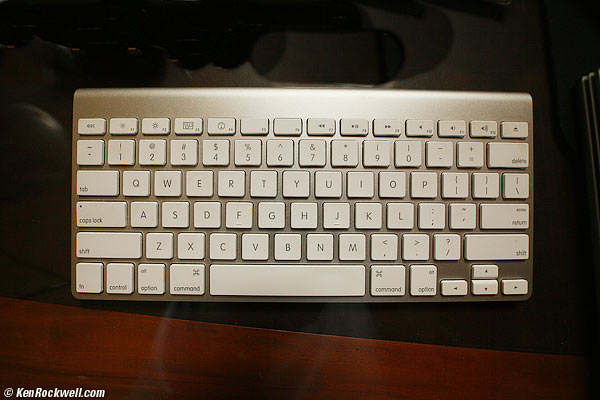
Zeiss 15mm f/2.8 on full-frame at close-focus distance (4" from front of lens).
Yes, at 4" from the subject there is more distortion, but so what: when you stick an ultrawide a few inches from something, its precisely because you're trying to distort something!
Mechanics and Construction Performance top
Rear, Canon version, Zeiss 15mm f/2.8 Distagon ZE. enlarge.
This is a dense, tough, all-metal lens built for men, not sissies.
Front fake hood extensions
Anodized aluminum.
Filter Threads
Anodized aluminum.
Barrel Exterior
Anodized aluminum.
Focus Ring
Anodized aluminum.
Focus Helicoids
Brass.
Depth-of-Field Scale
Yes!
Internals
Metal.
Mount
Dull-chromed brass.
Markings
Engraved and filled with paint, as God Himself intended.
Identity
Engraved inside filter threads on front of lens.
Serial Number
Engraved on front ring.
Dust seal at mount
No.
Noises when shaken
Very little clicking, in Canon mount.
You're more likely to accidentally throw it while shaking it than you are to hear anything significant rattling, at least in Canon EF mount that uses electronic control for the diaphragm.
Made in
Japan.
You want Made in Germany? It would cost $5,700 for exactly the same lens.
Weaknesses
Easy-to-drop slippery metal.
Your hands will stick to it in freezing weather.
Sharpness performance top
The Zeiss 15mm f/2.8 is the sharpest non-fisheye lens I've ever used shorter than 20mm. Bingo!
As I've covered at the introduction, this superior Zeiss lens makes today's plastic "professional" zooms and 14mm lenses from Canon look like they're broken by comparison if you're looking at digital images at 100% on your screen. I'm serious, this is why so many people think their Canon ultrawide lenses are defective, but that's just Canon's state-of-the-art today.
Nikon's 16-35mm and 14-24mm are much better than everything else from Nikon; when I get my hands on the Nikon version of this Zeiss lens, I'll compare them. It's the Canon shooters who need this lens; Nikon's two best are pretty good — but Nikon's 14mm is pretty bad, too.
Throughout most of the full-frame on a 21 MP Canon 5D Mark II, this Zeiss masterpiece is completely sharp and contrasty at every aperture. It can excite aliasing from roof tiles a quarter-mile away even at f/2.8! This is Zeiss' spy-satellite technology at work. Stop down if you need depth-of-field or less falloff, but not to get more sharpness. I see the image dulling from diffraction by f/5.6 or f/8!
At the farthest sides (image height = 18mm) on a 21 MP Canon 5D Mark II, it's much sharper than the sloppy lenses from Nikon and Canon at every aperture, and gets sharper as stopped down to f/8 as optimum. Smaller apertures get duller from diffraction.
In the farthest corners (image height = 21mm) on a 21 MP Canon 5D Mark II, it's much sharper than the sloppy lenses from Nikon and Canon at every aperture, and gets sharper as stopped down to f/11 as optimum. It's softer at f/16 and f/22 from diffraction.
Here are Zeiss' MTF curves:
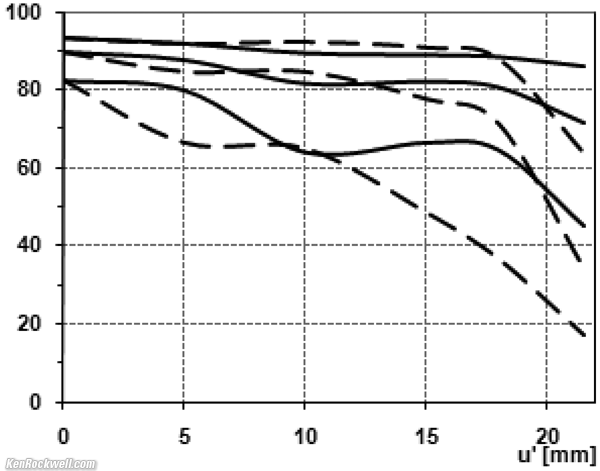
Zeiss 15mm f/2.8 MTF at f/2.8.
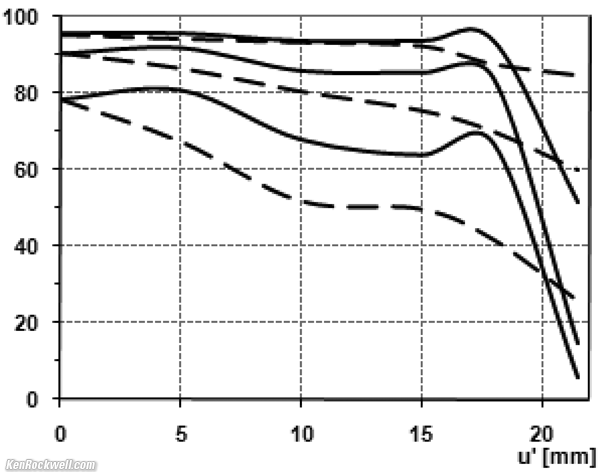 Zeiss 15mm f/2.8 MTF at f/5.6.
Zeiss 15mm f/2.8 MTF at f/5.6.
Sunstars performance top
The 9-bladed diaphragm makes asymmetrical 18-pointed sunstars on brilliant points of light. They're not that strong, and get strongest at f/22.

Zeiss 15mm f/2.8 sunstars at f/22.
On brilliant points of light like the sun glinting off glass, even at f/11 you'll get softer and more symmetrical 18-point sunstars.
Compared top
Intro Specs Performance Compared Recommendations
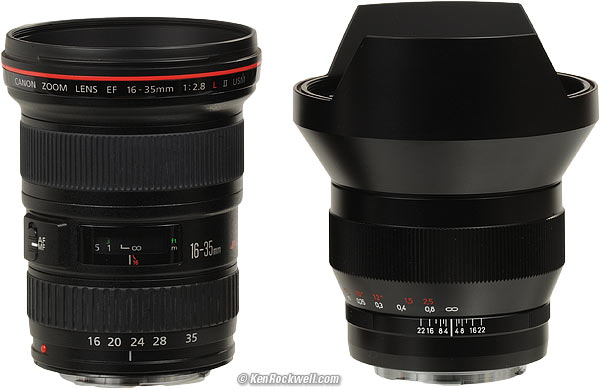
Canon 16-35mm f/2.8 II and Zeiss 15mm f/2.8.
As I've covered above, this Zeiss is much better optically and mechanically than Canon's ultrawide zoom and 14mm lenses. I still need to get my hands on a Nikon version to compare to Nikon's best.
Since it's manual-focus-only, this Zeiss is much less convenient than any of Nikon's or Canon's AF lenses.
Angle-of-View
When actually compared to the Canon 16-35mm f/2.8 II at 16mm, the Zeiss 15mm f/2.8 has just a tiny bit more angle of view. This is because the barrel distortion of the Canon 16-35 causes more to be squeezed into the edges, giving it a wider angle-of-view than an undistorted 16mm lens. Of course the Zeiss 15mm sees a bit wider, but it's much less distorted.
When actually compared to the Canon 14mm f/2.8, the Canon 14mm has a significantly wider view than the Zeiss 15mm f/2.8. 14mm versus 15mm is a 7% difference, and I see at least that much difference in actual angle of view.
Compared to Canon
| Anni | 2012- |
2007- |
2007- |
1991-2007 |
| Maximum Aperture | f/2.8 |
f/2.8 |
f/2.8 |
f/2.8 |
| Filter Size | 95mm |
82mm |
rear gel |
rear gel |
| Filter Threads | Metal |
Metal |
none |
none |
| Length | 133mm |
112mm |
94mm |
89mm |
| Sharpness | excellent |
good |
good |
fair |
| Distortion | Minor |
Strong |
almost none |
almost none |
| Diaphragm Blades | 9 |
7 |
6 |
6 |
| Sunstars | 18 points |
14 points |
6 points |
6 points |
| Focus | manual |
USM |
USM |
USM |
| Instant manual-focus override? | Yes |
Yes |
Yes |
Yes |
| AF/MF switch | none |
slide switch |
slide switch |
slide switch |
| Weight | 748g |
634g |
643g |
538g |
| Made in | Japan |
Japan |
Japan |
Japan |
| Price, 3/2012 | $3,000 |
Compared to Nikon
| Anni | 2012- |
2010- |
2007- |
2000- |
1978-2006 |
| Maximum Aperture | f/2.8 |
f4 |
f/2.8 |
f/2.8 |
f/3.5 |
| Filter Size | 95mm |
77mm |
none |
rear gel |
rear bayonet |
| Filter Threads | Metal |
plastic |
none |
none |
none |
| Length | 133mm |
125mm |
132mm |
87mm |
84mm |
| Sharpness | Excellent |
Excellent |
Excellent |
good |
fair to good |
| Distortion near 15mm | Minor |
heinous |
strong |
strong |
none |
| Distortion complexity | complex |
simple |
simple |
complex |
none |
| Diaphragm Blades | 9 |
9 |
9 |
7 |
7 |
| Sunstars | 18 points |
18 points |
18 points |
14 points |
14 points |
| Focus | manual |
AFS |
AFS |
Screw |
manual |
| Instant manual-focus override? | Yes |
Yes |
Yes |
no |
Yes |
| AF/MF switch | none |
slide switch |
slide switch |
locking ring |
none |
| Weight | 748g |
678g |
1,000g |
667g |
627g |
| Made in | Japan |
Japan |
Japan |
Japan |
Japan |
| Price, 3/2012 | $3,000 |
Recommendations top
Intro Specs Performance Compared Recommendations
This Zeiss 15mm lens is extraordinary. It's the best ultrawide SLR lens I've ever tested.
It's for people who demand the best image quality on their full-frame cameras, and don't worry about having to focus manually.
You Canon, tripod, HDR and pan-stitching guys are going to love this lens.
If you've found my efforts here in evaluating this lens and sharing these results, this free website's biggest source of support is when you use any of these links, especially this one to the Nikon ZF.2 version or this one to the ZE Canon version, when you get anything, regardless of the country in which you live. Thanks! Ken.
Canon
Canon users have no really sharp ultrawides available from Canon, so if you're serious about your image quality and need an ultrawide lens, this is your lens.
This Zeiss 15mm lens is so good that you can get great results on the 5D and 5D Mark II, saving you from having to shell out for the automatic lateral color fringe correcting 5D Mark III, since this Zeiss lens is devoid of the color fringes that plague Canon's ultrawides.
That's right: this Zeiss 15 is so good that the additional processing in the Mark III has nothing to do, so save your money and spend it on this lens instead. Canon's tele zooms are excellent; the only real need for the new correction ability of the Mark III is to try to make good for Canon's crummy ultrawides.
This Zeiss is marvelous, but heavy. The fixed Canon 14mm lenses are much smaller and lighter — and autofocus.
Nikon
Nikon's 16-35mm and 14-24mm lenses are already quite sharp, but loaded with easy-to-correct distortion.
This Zeiss lens is mostly of interest to the very serious Nikon user who doesn't want to lose sharpness lost in resampling pixels, which is an unavoidable artifact of software or firmware distortion correction.
© Ken Rockwell. All rights reserved. Tous droits réservés. Alle Rechte vorbehalten.
Help Me Help You
I support my growing family through this website, as crazy as it might seem.
The biggest help is when you use any of these links when you get anything. It costs you nothing, and is this site's, and thus my family's, biggest source of support. These places always have the best prices and service, which is why I've used them since before this website existed. I recommend them all personally.
If you find this page as helpful as a book you might have had to buy or a workshop you may have had to take, feel free to help me continue helping everyone.
If you've gotten your gear through one of my links or helped otherwise, you're family. It's great people like you who allow me to keep adding to this site full-time. Thanks!
If you haven't helped yet, please do, and consider helping me with a gift of $5.00.
As this page is copyrighted and formally registered, it is unlawful to make copies, especially in the form of printouts for personal use. If you wish to make a printout for personal use, you are granted one-time permission only if you PayPal me $5.00 per printout or part thereof. Thank you!
Thanks for reading!
Mr. & Mrs. Ken Rockwell, Ryan and Katie.

